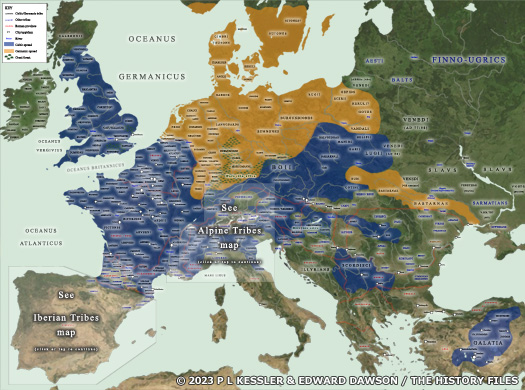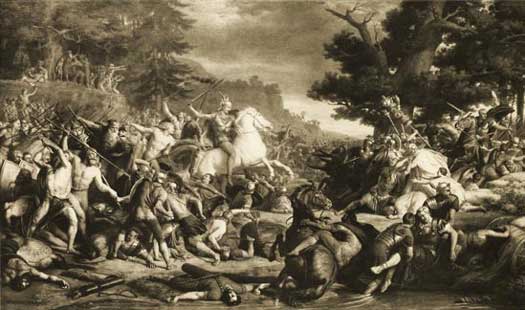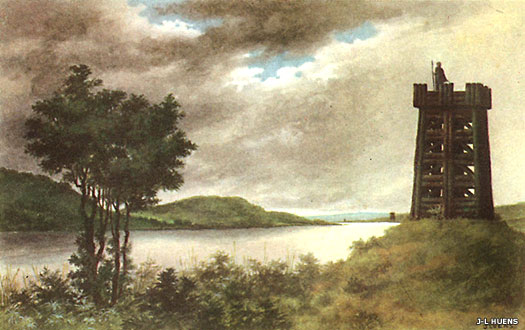| 53 BC |
The Germanic Cherusci encounter Rome for the first time, in the form of Julius Caesar, and are already established in their northern Rhine Valley homeland. Caesar identifies them separately from the Suevi when crossing the Rhine to punish the latter for aiding Gallic tribes. He states that the Bacenis forest divides them from the Suevi.  This vast map covers just about all possible tribes which were documented in the first centuries BC and AD, mostly by the Romans and Greeks, and with an especial focus on 52 BC (click or tap on map to view at an intermediate size) This vast map covers just about all possible tribes which were documented in the first centuries BC and AD, mostly by the Romans and Greeks, and with an especial focus on 52 BC (click or tap on map to view at an intermediate size) |
|
| 12 - 9 BC |
The Cherusci are subjugated by Rome, along with some of their neighbours in the first of four campaigns let by Nero Drusus, stepson of the emperor, who is appointed governor of the Rhine region of Gaul. After building a fortress on the island of the Batavi, he undertakes some difficult fighting in which he is generally successful, subduing numerous tribes. He progresses as far as the River Elbe, where he builds boats and sails to the North Sea. He is killed in a fall from his horse during the fourth campaign in 9 BC. |
|
| Sigimer |
|
|
| fl AD 8 - 21 |
Arminius / Erminaz / Hermann |
King of the Cherusci. The original 'Herman the German'. |
| Segestes |
Cherusci noble and rival contender for power. King in AD 21. |
|
| AD 9 |
Arminius (known as Herman Siegfried to modern Germans) declares the independence of the Cherusci from Rome with his decimation of three legions under Roman Governor Publius Quinctilius Varus. He achieves this momentous victory in an alliance with the Bructeri, Chatti, Chauci, Marsi, and Sicambri (a coalition which is sometimes, rather ridiculously, termed the Armenian empire). The Tencteri and Usipetes are also highly likely to be involved, as are the Dulgubnii, subjects of the Cherusci. The Bructeri, Tubantes and Usipetes certainly team up to harass the troops of Germanicus AD 14, and they are later included in his triumph. Segestes, whose daughter Arminius had married against his wishes, bears Arminius a lifelong grudge and this now flares up into open division.  The decimation of three legions in the Teutoberger wald was a massive humiliation for the Roman empire and caused the abandonment of plans to conquer Germania Magna The decimation of three legions in the Teutoberger wald was a massive humiliation for the Roman empire and caused the abandonment of plans to conquer Germania Magna |
|
| 14 - 15 |
Germanicus invades northern Germany with Segestes as an ally, and they start with the massacre of the Marsi. This enrages the Germanic tribes and Arminius' confederation is reformed willingly. After Roman forces (andBatavi allies) relieve Segestes from a siege which is being conducted by Arminius, Segestes hands over his pregnant daughter and she is taken to Rome where her son is born (he later trains as a gladiator and dies in combat before he reaches the age of twenty). |
|
| 16 |
The Cherusci suffer two defeats in this period, the first being at Idistaviso and then at the Battle of the Angrivarian Walls in the summer. Arminius doubtless finds his authority has been damaged by the second defeat, at least. |
|
| 17 - 19 |
War breaks out between Arminius and Maroboduus of the Marcomanni. The cause is Maroboduus' decision not to join the Cherusci-Roman war of AD 9 in common cause with his fellow Germans. Now the Cherusci join with some of Maroboduus' own Suevi subjects, the Langobards and theSemnones, to stage a revolt against his power. Following an indecisive battle, Maroboduus withdraws into territory which later forms Bohemia by AD 18. He is overthrown by one of his own nobles the following year. |
|
| 21 |
Segestes and members of the royal family murder Arminius, destroying Cherusci cohesion and allowing the Romans to appoint a client king. Following his appointment, Rome largely leaves the Cherusci to their own devices.  The Harz is now a national park in Germany to ensure that this primeval forest survives, but in the first century BC it was probably home to the Suevi The Harz is now a national park in Germany to ensure that this primeval forest survives, but in the first century BC it was probably home to the Suevi |
|
| Thumelicus |
Son of Arminius. Died as a gladiator in Rome. |
|
| 21 - ? |
Segestes |
Father-in-law of Arminius. Roman client. |
| 47 |
A request is sent to Rome asking that Italicus be sent to serve as king, after the nobility of the Cherusci has been destroyed by internal conflict. Whether or not Segestes is killed before this point is entirely unknown. The new, Roman-educated prince soon falls out of favour with his people and they attempt to expel him. The Langobards, previously a minor tribe under the dominance of the once-mighty Cherusci and Marcomanni, now appear on the scene with enough authority and strength to impose the restoration of Italicus. |
|
| 47 - c.50 |
Italicus |
Nephew of Arminius. Roman client. Soon fell out of favour. |
| fl 90s |
Chariomerus |
King at the time of Tacitus' Germania. |
| late 1st century |
Cherusci numbers and fighting ability have been dented through unsuccessful warfare against the Chatti. This point signals their eclipse and eventual absorption by other tribes. |
|
| 117 - 138 |
Emperor Hadrian spends much of his career consolidating the [Roman](ItalyRomeEmpire.htm#Adoptive Emperors) empire and securing its borders. This includes the building of limes, or defensive works, along the Rhine to keep out possible future Germanic incursions, although it is probably Hadrian's successor, Antoninus, who completes much of this work.  The Roman borders, called limes, were fortified with broad wooden towers in which soldiers stood guard to warn of potential infringements The Roman borders, called limes, were fortified with broad wooden towers in which soldiers stood guard to warn of potential infringements |
|
| 3rd century |
The Germanic [Franks](FranceFranks.htm#Tribal Leaders) are first documented during this century (the 'Period of Migration'), when they are to be found occupying territory on the Lower Rhine valley (on the east bank, in what is now northern Belgium and the southern[ Netherlands](FranceHolland.htm#Kingdom of Holland %28Orange%29)). They are one of several West Germanic federations, and are formed of elements of the Ampsivarii, Batavi, Bructeri, Chamavi, Chatti, Chattuarii, Cherusci,[Salii](FranceFranks.htm#Tribal Leaders), Sicambri, Tencteri, Tubantes, and Usipetes. Most of these peoples live along the Rhine's northern borders in what is becoming known as Francia. The fortunes of all of these tribes are now tied to the greater Frankish collective. Elements of the Cherusci and their subjects, including the Dulgubnii, are also in the process of being absorbed into the Saxon tribal confederation. They disappear from history as an identifiable people. |
|
 |
|
|
 This vast map covers just about all possible tribes which were documented in the first centuries BC and AD, mostly by the Romans and Greeks, and with an especial focus on 52 BC (click or tap on map to view at an intermediate size)
This vast map covers just about all possible tribes which were documented in the first centuries BC and AD, mostly by the Romans and Greeks, and with an especial focus on 52 BC (click or tap on map to view at an intermediate size) The decimation of three legions in the Teutoberger wald was a massive humiliation for the Roman empire and caused the abandonment of plans to conquer Germania Magna
The decimation of three legions in the Teutoberger wald was a massive humiliation for the Roman empire and caused the abandonment of plans to conquer Germania Magna The Harz is now a national park in Germany to ensure that this primeval forest survives, but in the first century BC it was probably home to the Suevi
The Harz is now a national park in Germany to ensure that this primeval forest survives, but in the first century BC it was probably home to the Suevi The Roman borders, called limes, were fortified with broad wooden towers in which soldiers stood guard to warn of potential infringements
The Roman borders, called limes, were fortified with broad wooden towers in which soldiers stood guard to warn of potential infringements